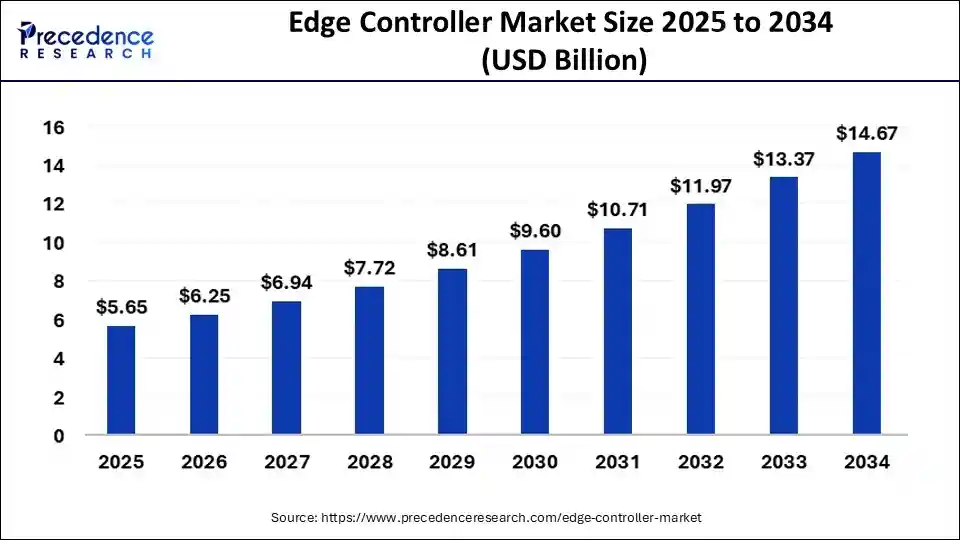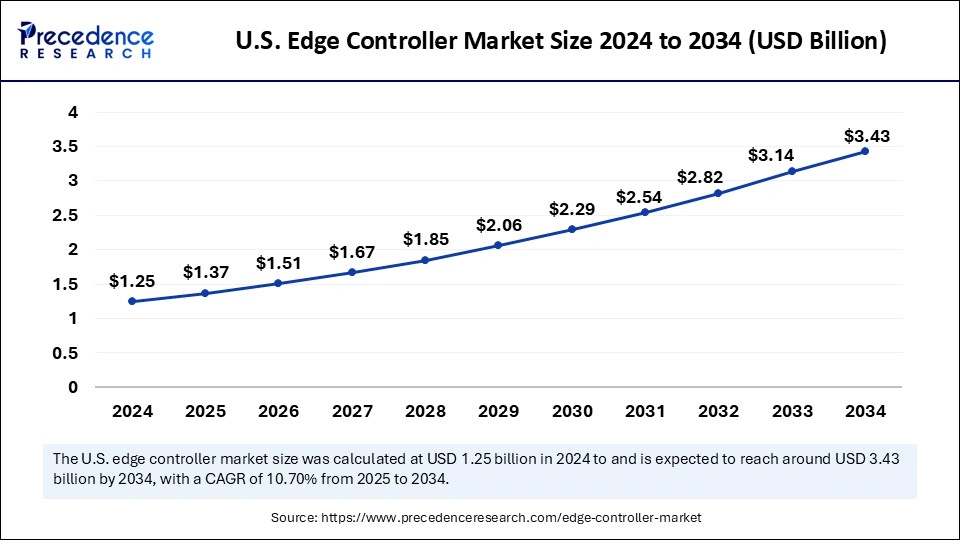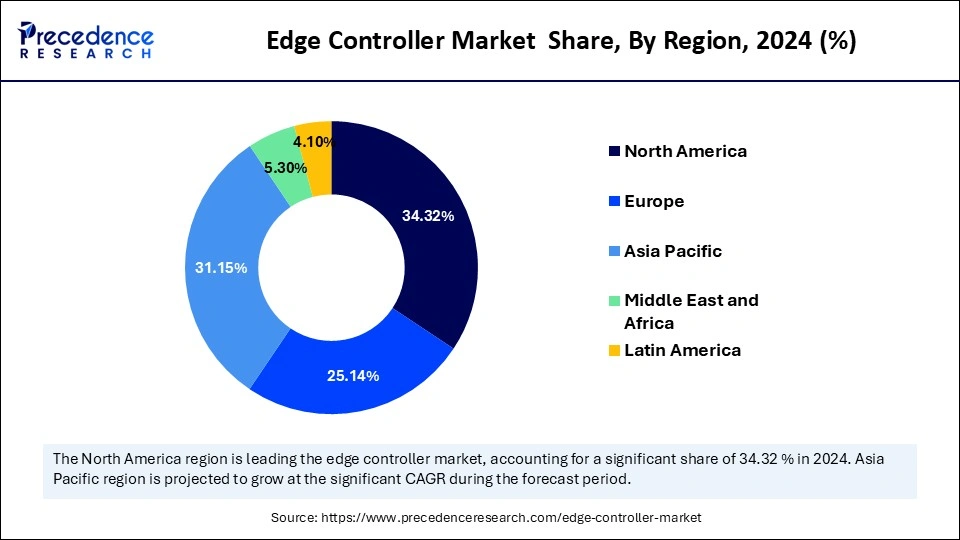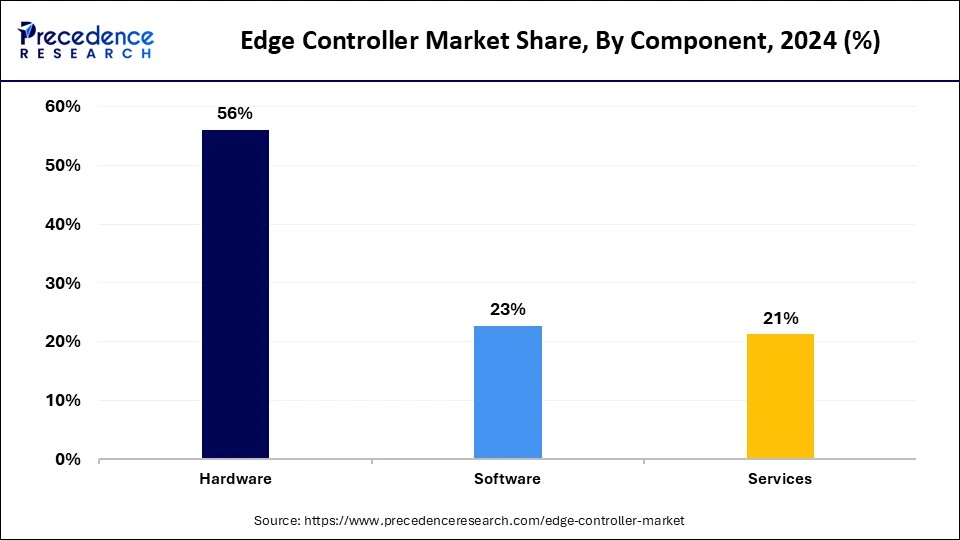August 2024
The global edge controller market size is calculated at USD 5.65 billion in 2025 and is forecasted to reach around USD 14.67 billion by 2034, accelerating at a CAGR of 11.20% from 2025 to 2034. The North America market size surpassed USD 1.75 billion in 2024 and is expanding at a CAGR of 10.20% during the forecast period. The market sizing and forecasts are revenue-based (USD Million/Billion), with 2024 as the base year.
The global edge controller market size was estimated at USD 5.11 billion in 2024 and is predicted to increase from USD 5.65 billion in 2025 to approximately USD 14.67 billion by 2034, expanding at a CAGR of 11.20% from 2025 to 2034. The edge controller market is experiencing significant growth due to the rising adoption of smart manufacturing technologies and IoT. The rising emphasis on decentralized systems for highly secure data transmission across various industries further supports market growth.

The integration of Artificial Intelligence with edge controller significantly impacts market growth, enabling smarter, data-based, and autonomous decision-making at the edge before proceeding with the data toward the next phase. IoT devices can analyze the data locally at the edge by integrating AI with the edge controller while reducing reliance on cloud infrastructure. Due to this, critical operations like quality control and fault detection can be solved easily within a shorter time frame, increasing the working efficiency of the systems. AI also helps in the data aggregation function of the edge controller to transmit relevant information only for bandwidth efficiency. Moreover, AI-powered edge controllers effectively improve operational efficiency, minimize downtime, and enable adaptive learning with data patterns over time.
The U.S. edge controller market size was evaluated at USD 1.25 billion in 2024 and is projected to be worth around USD 3.43 billion by 2034, growing at a CAGR of 10.70% from 2025 to 2034.

North America registered dominance in the edge controller market by capturing the largest share in 2024. This is mainly due to its robust industrial base. There is high adoption of advanced technologies, such as IoT and automation, boosting the demand for edge controllers for data collection and analysis. A strong emphasis on smart manufacturing and digital transformation across different sectors like energy, transportation, and healthcare further boosts the adoption of edge controllers. In addition, the increased renewable energy integration and rapid adoption of edge computing technologies bolstered the market growth in the region.
Asia Pacific is expected to witness the fastest growth in the coming years. The growth of the edge controller market in Asia Pacific can be attributed to factors like rapid industrialization and the increasing adoption of automation solutions and IoT devices in various industries. The demand for edge controllers is surging more than ever before due to a strong focus on smart manufacturing and digitization. Governments around the region are also promoting the use of smart technologies to support industrial automation, which contributes to regional market growth.

China is projected to have a stronghold on the market in Asia Pacific. This is mainly due to technological advancements like cloud computing, industrial Internet of Things (IIoT), AI, VR/VR, and robotics. Moreover, there is a high adoption of digital and smart technologies among businesses, boosting the demand for edge controllers for data analysis.
An edge controller is an integral part of the Internet of Things (IoT), which integrates the operational technology of the manufacturing sector and information technology along with factory automation. Due to its balancing approach, it is considered a highly advanced form of the traditionally used programmable logical controller. Edge controllers play a vital role in networking systems as they offer a centralized point from which traffic management and data security are effortlessly possible. The edge controller offers a programming background for the development of data collection and its precise analysis with monitoring. Edge controller also supports Industry 4.0 by providing a user-programmable edge controller platform with the help of its real-time operating system.
The demand for edge controllers is increasing at a rapid pace due to their excellent capacity to support various industrial networking, IIoT, and advanced protocols like PROFINET, SRTP, and others. Edge controllers can enhance equipment control, making them highly suitable for modern industrial protocols, physical communication ports, and security features.
| Report Coverage | Details |
| Market Size by 2034 | USD 14.67 Billion |
| Market Size in 2025 | USD 5.65 Billion |
| Market Size in 2024 | USD 5.11 Billion |
| Market Growth Rate from 2025 to 2034 | CAGR of 11.20% |
| Dominated Region | North America |
| Fastest Growing Market | Asia Pacific |
| Base Year | 2024 |
| Forecast Period | 2025 to 2034 |
| Segments Covered | Component, Application, Industry Vertical, Function, and Regions |
| Regions Covered | North America, Europe, Asia-Pacific, Latin America and Middle East & Africa |
Strong Security and Adaptability Features to Boost the Adoption of Edge Controllers
A major driving factor for the edge controller market is the robust security protocols and adaptability features offered by edge controllers in various industries. By recognizing the current condition of different components, edge controllers identify possible machine failure without human intervention. This allows machine operators to access detailed information about faults, making edge controllers more reliable for fault detection. Additionally, rapid multi-system integration has become a major attribute for advanced control systems. These systems allow workers to generate advisory algorithms to direct newer teams with maintaining and operating systems, further driving the market. A large number of skid-mounted systems can be integrated easily and efficiently with the help of edge controllers.
Lack of Interoperability and Standardization
The notable restraining factor for the edge controller market is the lack of interoperability between different edge controllers and standardized protocols. This creates compatibility issues and increases security threats. Ensuring the security and privacy of data collected and processed by edge controllers at the edge is crucial. However, the lack of robust security measures limits the adoption of edge controllers.
Adoption of Smart Manufacturing and IIoT
The significant opportunity that the edge controller market holds is the rising adoption of smart manufacturing and IIoT in several end-use industries to enhance operational efficiency and product quality and reduce operational costs. A smart manufacturing system has been transformed due to these edge controllers by offering seamless communication between interconnected devices and real-time data processing, which further helps in timely decision making. Edge controllers play a critical role in managing various sensors, machines, and other industrial equipment. Also, edge controllers reduce latency and allow machines to operate at a higher efficiency due to data being handled at the local level, ensuring optimized manufacturing processes. Edge controllers are popular for their integration capabilities and connectivity as they support several communication protocols, creating lucrative opportunities in the market.
The hardware segment held the largest share of the edge controller market in 2024. This is mainly due to the increased demand for sensors. There is a heightened need for high performance and real-time data processing at the edge, boosting the demand for hardware like sensors. The rapid increase in the adoption of smart technology and industrial IoT has boosted the demand for reliable and robust hardware to handle huge amounts of data. Edge devices require hardware components like processors, sensors, and microcontrollers to support automation effectively without being dependent on cloud connectivity.

The services segment is expected to grow at the fastest rate during the forecast period. The growth of the segment can be attributed to the increasing need to handle complex edge computing systems that require proper installation, maintenance, and support services. Many enterprises are looking for services to manage uninterrupted operation and cybersecurity of edge computing. Moreover, the inclination toward subscription-based models and remote management further fuels the service segment.
The power generation segment dominated the edge controller market with the largest share in 2024. This is mainly due to a strong emphasis of power plants in improving grid stability. Edge controllers manage and balance power distribution within the grid. They also monitor and analyze data from power generation equipment in real-time. Edge controllers allow faster data processing at the source, which further helps to manage load distribution, fault recognition, and predictive maintenance for power systems. The power sector is gradually shifting toward smart grids and renewable energy sources, which raises the demand for decentralized and highly efficient control systems, further increasing the adoption of edge controllers in the power sector.
The energy storage segment is anticipated to grow at the fastest rate in the upcoming period. Renewable energy sources like solar and wind heavily depend on energy storage systems. Edge controllers monitor and analyze real-time data from energy storage systems, optimizing their efficiency. The rising adoption of smart grids and decentralized power systems further boosts segmental growth.
The manufacturing plants segment dominated the edge controller market in 2024. Over the past several years, manufacturing plants have seen revolutionary changes and notably shifted from traditional manufacturing to smart manufacturing practices. This further encouraged manufacturers to adopt edge controllers for real-time data analysis at the source and initiate effective communication between machines and devices. Moreover, the increased adoption of automation solutions in manufacturing industries boosted the demand for edge controllers to enhance efficiency.
The utilities segment is projected to expand at the fastest rate in the foreseeable period. The segment's growth can be attributed to a strong emphasis on modernizing power grids and increasing demand for smart utility infrastructure. Edge controllers can efficiently detect faults in real-time and balance load on grids, which are key aspects of the utilities. Additionally, the rising demand for clean energy supports market growth. Edge controllers facilitate the integration of distributed energy resources like solar and wind into the grid.
The data aggregation segment held the largest market share in 2024. The growth of the segment is driven by the growing adoption of IoT and automation across various industries where data management is crucial. Edge controller offers an efficient solution for data management. Data aggregation plays an important role as it is an essential function of edge controllers for collecting, filtering, and effectively organizing the huge amounts of data generated by edge devices.
The security management segment is observed to expand at the fastest ratein the foreseeable period. Security management plays a critical role in the edge controller, as it offers proper shielding against the growing risk of cyber threats and data breaches in decentralized systems. Many devices are connected to the edge, making it difficult to secure simultaneously. Thus, edge controllers require highly advanced security features like encryption and authentication to protect sensitive data.

By Component
By Application
By Industry Vertical
By Function
By Region
For inquiries regarding discounts, bulk purchases, or customization requests, please contact us at sales@precedenceresearch.com
No cookie-cutter, only authentic analysis – take the 1st step to become a Precedence Research client
August 2024
September 2024
September 2024
March 2025